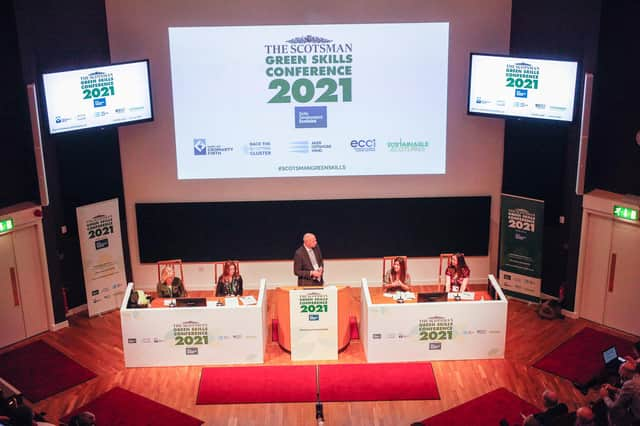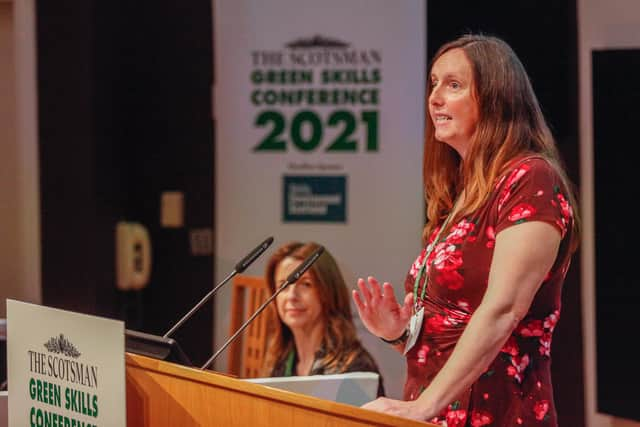Green Skills Conference: Scotland ready for the skills transition


Floating wind and green hydrogen are two areas where Scotland could gain a global advantage – if these and other industries can develop at the pace and scale needed to provide tens of thousands of newclimate-friendly jobs as the oil and gas industry contracts.
The conference, held at the Royal College of Physicians of Edinburgh, discussed in detail the “just transition” required to shift the energy focus from oil and gas to renewables over the coming decades – but learned that it will be a complicated process.
Advertisement
Hide AdAdvertisement
Hide Ad“The oil and gas industry is in managed decline,” Joanne Allday, strategic business development manager at Port of Cromarty Firth, told the event. “No-one is talking about switching off the taps.


“If we did, we would have to import oil and gas from other sources which are not decarbonising at the same rate as our own industry.
“We can see what’s coming – this is the first time we have been able to see so far into the future and take a proactive approach.”
Allday went on to say that the Aberdeen oil and gas industry and a renewables hub in the Cromarty Firth could work in partnership: “Over the coming years it’s about complementing the oil and gas industry and not replacing it.”
The big opportunities, she noted, were in floating wind energy in the North Sea and green hydrogen. These areas, plus carbon capture and storage, could play a big part in the jobs transition away from oil and gas, the conference heard.
Marissa Lippiatt, head of climate emergency and high value manufacturing at Skills Development Scotland, laid out the scale of the skills challenge.
“The climate emergency is the biggest single challenge to the skills landscape and requires huge change across the economy, but it brings with it huge opportunity,” she said. “It’s a transformational opportunity, but the pace and scale also brings with it risks and disruptions.”
Both Joanne Allday and Sian Lloyd Rees, managing director of Aker Offshore Wind, stated that Scotland has the chance to be at the forefront in floating wind – but has to act fast.
Advertisement
Hide AdAdvertisement
Hide AdScotland currently has between 1 and 2 gigawatts of offshore wind power generation in place, but this is set to rise to 11GW by 2030, with some estimates suggesting each extra 1GW of capacity adds 5,000 jobs per year, and many more during construction.
Allday said the real opportunity was floating wind power, which could be deployed in harsher conditions further out to sea. “With floating wind, we should be able to make more components in Scotland [including wind turbine towers],” she observed.
Lloyd Rees added: “We need a lot of skills and capabilities to take this offshore wind opportunity forward. There are 160,000 people still employed in the oil and gas industry and their skills are hugely relevant to wind.”
These areas of relevance included engineering and construction – including floating foundations –project management, the subsea environment, operation and maintenance and digital expertise.
“Transitioning those skills needs a lot of engagement,” Lloyd Rees said. “We need to ask where are the strengths and capabilities and where are the gaps”.
Plugging these gaps would involve drawing on skills from a wide range of other occupations – not just oil and gas – she said, and diversifying the workforce. Not just looking at technical skills, but also leadership, project management and communication.
Lloyd Rees went on to argue that retaining staff, not recruiting them, was the biggest challenge. “We need to look at the career path, and ask what they want,” she told delegates. “That might be very different to what previous generations have wanted – it’s more about developing individuals and giving them skills they can transport across different industries throughout their careers.”
She added that new skills would also be needed for the new energy world, in areas such as hydrogen gas handling and transportation, making and using electrolysers to create green hydrogen, and complex project management in carbon capture and storage .
Advertisement
Hide AdAdvertisement
Hide Ad“If you can get ahead of the technology curve, it’s very hard for people to catch up,” she said. “But we also need to get the supply chain ready and have the skill sets we need ready.”
Joanne Allday agreed: “Commercial deployment of floating wind and green hydrogen is likely to happen first in Scotland. We could have a first-mover advantage if we build a supply chain with skills and expertise that can then be exported in the future.
“Not all floating wind components will be built in the UK. But let’s focus on the areas where we can win.”
Allday illustrated the scale of the challenge by describing how turbine blades had increased in size, from 45 metres to 85 metres, and would increase to potential 120 metres. This would require huge amounts of space for construction, but also huge numbers of people.
She quoted one developer, discussing a very large offshore wind project with the Port of Cromarty Forth, who estimated it would need up to 5,000 welders!
Allday said there was also a “big opportunity” with green hydrogen, which was moving faster than expected (see panel, below).
She added: “The size of the prize is so big that we cannot achieve it on our own and requires enormous levels of collaboration”.
She went on to describe how 14 different organisations had come together in the Opportunity Cromarty Firth initiative to deliver the economic and employment – as well as environmental – benefits of the great shift to green energy.
Advertisement
Hide AdAdvertisement
Hide AdConference chair Dave Reay, executive director of the Edinburgh Climate Change Institute, said that both regional and Scotland-wide collaboration – and making it meaningful – was vital to seizing the opportunity.
“Collaboration is key,” he told delegates. “It’s not that we need to do it, we are already doing it.
“Scotland is showing the way. We are making mistakes, but as long as we are collaborating and communicating successes and failures, and sharing that internationally, we really will punch above our weight.
“Scotland has done this for centuries, and the place that delivered the enlightenment now has the chance to lead a new climate enlightenment.”
Green and blue components quicken their pace
Green hydrogen is seen as a key component of Scotland’s environmental ambitions.
It is produced through electrolysis, which separates water into hydrogen and oxygen, using electricity generated from renewables.
It can be used to transfer or store energy, and as an energy in itself. It can be added to natural gas to burn in heating plants, or to directly power fuel cells in HGVs, buses and ships.
Blue hydrogen is created mainly from natural gas and heated water in a “steam reforming” process. The output is hydrogen, but has carbon dioxide as a by-product, so carbon capture and storage is needed for CO2 emissions.
Advertisement
Hide AdAdvertisement
Hide AdBlue hydrogen is easier to produce now because natural gas is readily available.
Green hydrogen was seen as being further into the future but has picked up pace, with a project set to start production in the Cromarty Firth in 2024.
It is led by ScottishPower and Storegga and the first green hydrogen produced will be used to power whisky distilleries. Glenmorangie, Whyte & Mackay and Diageo were all partners in the feasibility study. The project could see the largest electrolyser producing green hydrogen in the UK.
“There is a lot of money being put into blue hydrogen, because it’s coming more quickly,” says Joanne Allday of the Port of Cromarty Firth. “But we are seeing green hydrogen move more quickly and it will reach cost parity [with other fuels] faster than we thought.
“We need blue hydrogen but not at the expense of investing in green. We have the opportunity to export green hydrogen in future and most European countries want to import green rather than blue.”